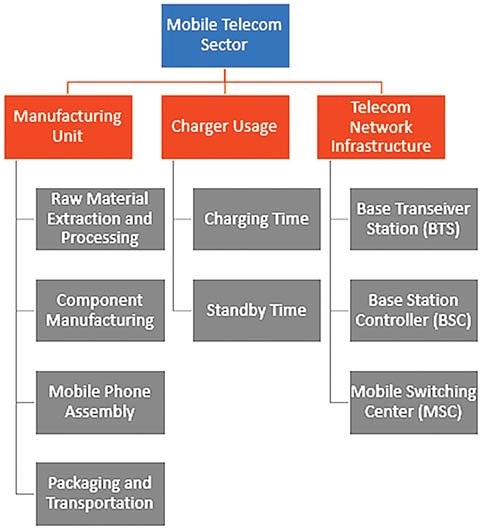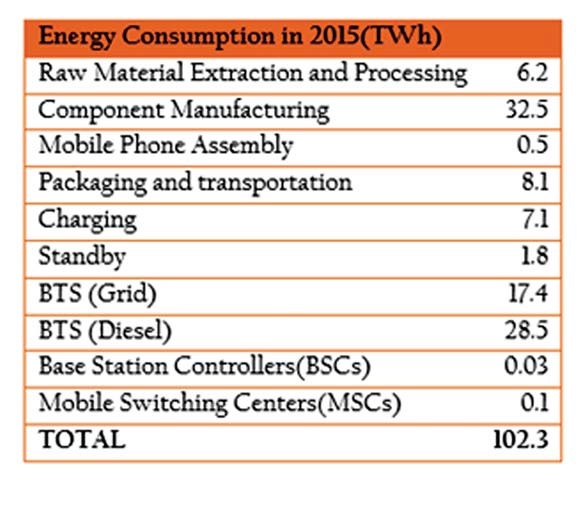The mobile sector emitted 58 million tonnes of CO2 in 2014-15. Murali R. Ananthakumar offers options about how it can bring this down
Under the umbrella of NAPCC, the National Solar Mission (NSM) and National Mission on Enhanced Energy Efficiency (NMEEE) are two key initiatives that aim to shift our dependence on fossil fuel to green energy and promote efficient consumption of energy. This article assesses the overall impact of the Indian mobile telecom sector on the energy scenario and examines potential options to reduce its dependence on fossil fuel, especially diesel.
The Indian telecom subscription has reached a new record in May 2015, according to the Telecom Regulatory Authority of India (TRAI). Using a Life Cycle Analysis (LCA) approach, this article examines the overall energy consumption of the mobile telecom sector, and its associated carbon dioxide (CO2) emissions. State and Central policies, such as REC (Renewable Energy Certificates) and Renewable Purchase Obligation (RPO), to foster growth in solar energy utilisation across sectors have also been studied to understand bottlenecks, if any.
Structure of the mobile telecom sector
The mobile telecom sector is categorised into three divisions and various sub-divisions where energy and associated emissions are calculated. This approach is applied to calculate the amount of energy required to manufacture a mobile device, and then to provide signal via service providers, including device usage (charging time). Using this bottom-up approach, the total amount of energy consumed in 2014-15 was estimated to be 103 Terawatt hour (TWh) (A terawatt hour is equivalent to one billion units. The 103 TWh takes into account both grid and diesel power supplied to all the base transceiver stations operated across the country).
The manufacturing unit and telecom network infrastructure consumed about 46% and 45% of energy respectively, while device usage accounted for the remaining 9%. The component manufacturing segment, within the manufacturing unit, consumes 68% of 47.43 TWh (the total amount of energy consumed by the segment). It encompasses designing integrated circuits using components such as capacitors, transistors and resistors that are mounted on a printed circuit board for every variety of handheld devices. The telecom network infrastructure takes into account all the towers (referred to as Base Transceiver Stations or BTS) providing signal to mobiles across the country. These towers are usually powered by the grid, with diesel generator sets providing power during power outage. The energy consumed by BTS was about 28.5 TWh.
Direct emissions associated with the mobile telecom sector are primarily due to the diesel consumed by the towers. More than three and a half billion litres (number of towers: 0.4 million and average diesel consumption of a tower is 8760 litres every year) of diesel was consumed by the Indian telecom industry in 2011, according toa report published by TRAI. An estimated total of 58 million tonnes of CO2 was emitted by the telecom industry in 2015 – and out of this, 37.5% can be attributed to the telecom network infrastructure and 12.6% is due to mobile usage. The manufacturing unit accounts for the remaining half of the emissions in the telecom industry.
Policy Landscape
In order to reduce the carbon footprint of the telecom sector, dependency on diesel needs to be minimised, along with technology upgradation with a focus on energy efficiency. Component manufacturing and diesel-powered towers consume 61 TWh of the total 102.3 TWh. Hence, implementation of energy efficiency measures in the component manufacturing division and substituting diesel with green energy are two key measures that need to be undertaken to reduce the sector’s energy and emission footprint. These are the low-hanging fruits for attaining energy savings. However, very little has been done to address opportunities for diesel abatement. Thus, we narrowed our focus on the network infrastructure division, to understand the potential of green energy substitution and technology upgradation, for a scenario-based analysis.
To calculate the renewable energy potential, three scenarios (explained below) were employed.
Scenario 1: In the Business as Usual (BAU) scenario, no changes were considered in the current infrastructure. Further, 2016 onwards all new towers will be upgraded to and powered by renewable energy. Compact BTS weigh lighter (15kg) than the traditional ground-based BTS (100-200kg) and distributed BTS (30-145kg). They also consume less power (65-150W) as compared to its predecessors.
Scenario 2: In this scenario, around 25% of the existing installations until 2015 and all new installations from 2016 are assumed to be powered by renewable energy. In addition, all the towers installed from 2016 have been assumed to be compact BTS.
Scenario 3: Around 50% of the towers are to be powered by renewable energy, while the remaining 50% will be powered by both the grid (25%) and diesel (25%) for towers installed before 2015. It has been assumed that all the installations from 2016 will be compact BTS.
From the results of our analysis, it has been observed that the third scenario yielded more energy and emissions savings as compared to the BAU scenario. Around 70% of CO2 savings potential has been estimated by implementing energy efficient technology and green energy penetration. The current policy landscape offers few incentives to the telecom sector for solar power installations. If a tower chooses to install renewable energy system, they can avail credits for the generated energy.
Telecom towers can be categorised under ‘industrial sector’ in grid connected rooftop solar power project specification based on this notice. Associated benefits, for setting up grid connected rooftop and small solar plants are prioritised based on the nature of the consumer – where industrial entities are lined up only after five other sectors. The overall electricity consumed by the telecom sector is high enough to revise (increase) the RPO targets of a State, if all the telecom towers opt to install renewable energy technology.
In conclusion, considering the power consumption and emissions share of the telecom industry, it would be beneficial for the sector to participate and ‘greenergise’ our economy.












